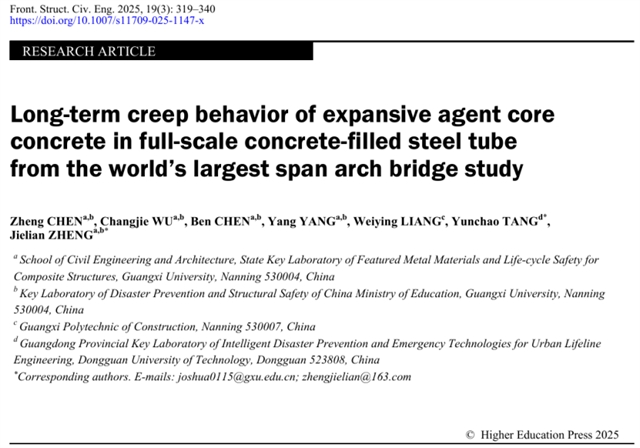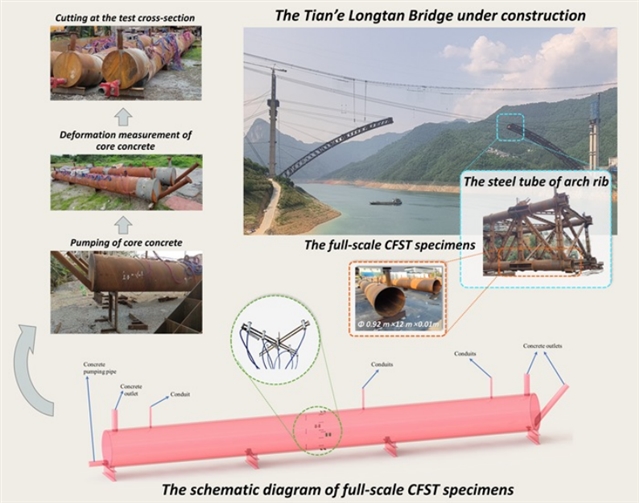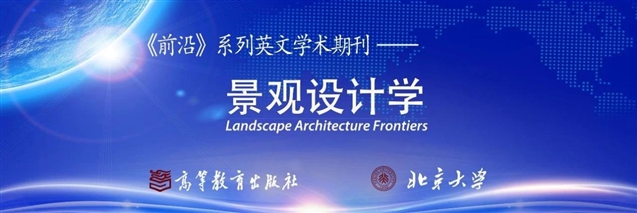|
|
|
|
|
FCSE 文章速递 | 世界最大跨度拱桥足尺钢管混凝土中膨胀剂核心混凝土的长期徐变性能研究 |
|
|
论文标题:Long-term creep behavior of expansive agent core concrete in full-scale concrete-filled steel tube from the world’s largest span arch bridge study
期刊:Frontiers of Structural and Civil Engineering
作者:Zheng CHEN, Changjie WU, Ben CHEN, Yang YANG, Weiying LIANG, Yunchao TANG, Jielian ZHENG
发表时间:17 Jul 2024
DOI:10.1007/s11709-025-1147-x
微信链接:点击此处阅读微信文章

文章亮点/Highlights
目前正建的世界上最大跨度拱桥——天峨龙潭大桥(主跨600 m),采用钢管混凝土(CFST)作为主要承力骨架,外部浇筑钢筋混凝土拱圈的结构形式。鉴于CFST内部缺陷在外部混凝土包裹后不可修复的特性,核心混凝土与钢管界面的长期粘结性能成为关键控制因素。
近年来,膨胀剂在CFST拱桥工程中被广泛应用,以补偿早期自收缩和温度收缩。然而,钢管约束条件下核心混凝土的膨胀-徐变耦合行为机制尚未明确。本研究提出将径向膨胀过程划分为脱粘阶段和约束阶段,基于弹性力学和线性徐变理论,建立了约束阶段核心混凝土径向膨胀的长期变形模型,并通过分段函数实现了两阶段膨胀过程的统一描述。依托天峨龙潭大桥实体工程,对掺加和未掺加膨胀剂的足尺CFST试件(Φ0.92 m×12 m×0.01 m)进行了长达114天的核心混凝土性能测试,验证了该徐变模型的实用性并确定了其相关参数。
结果表明,核心混凝土初凝前出现了0.142 mm的界面脱粘间隙;总径向膨胀应变达 290.1×10-6,其中158.3×10-6用于补偿早期脱粘,剩余131.8×10-6形成钢管自应力。徐变模型显示,在钢管的环向限制下,核心混凝土的径向徐变历时约6个月,最终产生26.4×10-6的残余膨胀应变和0.119 MPa的残余应力。此外,未掺加膨胀剂的未掺膨胀剂试件呈现由外至内的约束力梯度分布,而膨胀剂可有效均化截面应力状态。
由此,研究推导了钢管约束下核心混凝土的轴向长期膨胀模型。最后,将实验室试件的变形数据引入模型,提高了模型的实用性,结果表明实测数据与模型具有良好的一致性。研究所得的实验结果和理论模型为量化钙基和镁基复合膨胀剂在钢管混凝土拱桥拱顶的膨胀性能提供了重要支持。

全尺寸实验示意图
摘要/Abstract
The Tian’e Longtan Bridge, currently under construction and boasting the world’s largest span arch at 600 m, employs a concrete-filled steel tube (CFST) as its primary structural component, forming the stiffness skeleton upon which an outer reinforced concrete arch ring is constructed. As the internal defects of CFST, once encased by outer concrete, cannot be remedied, it becomes imperative to prevent long-term debonding of the core concrete. In recent years, expansion agents have been extensively utilized in CFST arch bridge engineering to compensate for early autogenous and thermal shrinkage. However, a comprehensive comprehension of the creep behavior of core concrete expansion under extended steel tube confinement remains elusive. To address this concern, the radial expansion process of the core concrete can be segmented into two stages: debonding and restriction. We derive a long-term deformation model for the radial expansion of core concrete during the restriction stage, based on elastic mechanics and linear creep mechanics. We represent the expansion process of these two stages uniformly using piecewise functions. Subsequently, in conjunction with the ongoing construction of the Tian’e Longtan Bridge, we measure the core concrete’s behavior in full-size CFST specimens (Φ0.92 m × 12 m × 0.01 m) both with and without expansion agents for up to 114 d. This validates the practicality of the creep model and enables us to determine its relevant parameters. Our results reveal that a debonding gap of 0.142 m occurred before the initial setting of the core concrete. The core concrete underwent a radial expansion of 290.1 × 10−6, with 158.3 × 10−6 being used to address early debonding, and the remaining 131.8 × 10−6 generating self-stress on the steel tube. The creep model indicates that radial creep of the core concrete persisted for approximately six months under the hoop limitation of the steel tube, resulting in a residual expansion deformation of 26.4 × 10−6 and a residual self-stress of 0.119 MPa. Additionally, axial deformation results of CFST without expansion agents demonstrated a decreasing constraining force of the steel tube on the core concrete from the outer to the inner sections, attributable to local core concrete yield. Conversely, the inclusion of an expansion agent altered the stress state of the core concrete, maintaining consistent constraining forces within the same section. As a result, we derive an axial long-term expansion model for the core concrete under steel tube restriction. Finally, the introduction of laboratory specimen deformations enhances the practicality of our model, with results demonstrating strong alignment between measured data and the model. The experimental findings and theoretical models developed provide critical support for quantifying the expansion behavior of CaO and MgO-based compound expansive agents in the vault of CFST arch bridges.
关键词/Keywords
CFST; autogenous shrinkage; restriction; expansion agent; principle of creep superposition
引用信息/Citation Information
Zheng CHEN, Changjie WU, Ben CHEN, Yang YANG, Weiying LIANG, Yunchao TANG, Jielian ZHENG. Long-term creep behavior of expansive agent core concrete in full-scale concrete-filled steel tube from the world’s largest span arch bridge study. Front. Struct. Civ. Eng., 2025, 19(3): 319–340 https://doi.org/10.1007/s11709-025-1147-x
全文下载/Full paper access

获取全文
https://doi.org/10.1007/s11709-025-1147-x

《前沿》系列英文学术期刊
由教育部主管、高等教育出版社主办的《前沿》(Frontiers)系列英文学术期刊,于2006年正式创刊,以网络版和印刷版向全球发行。系列期刊包括基础科学、生命科学、工程技术和人文社会科学四个主题,是我国覆盖学科最广泛的英文学术期刊群,其中12种被SCI收录,其他也被A&HCI、Ei、MEDLINE或相应学科国际权威检索系统收录,具有一定的国际学术影响力。系列期刊采用在线优先出版方式,保证文章以最快速度发表。
中国学术前沿期刊网
http://journal.hep.com.cn

特别声明:本文转载仅仅是出于传播信息的需要,并不意味着代表本网站观点或证实其内容的真实性;如其他媒体、网站或个人从本网站转载使用,须保留本网站注明的“来源”,并自负版权等法律责任;作者如果不希望被转载或者联系转载稿费等事宜,请与我们接洽。